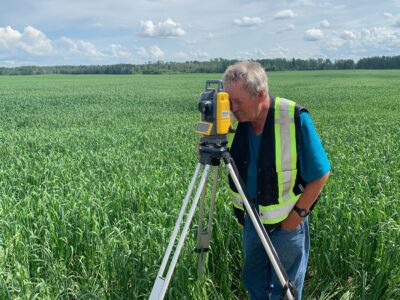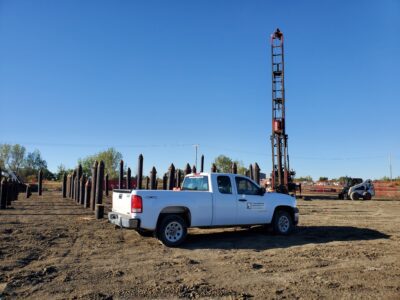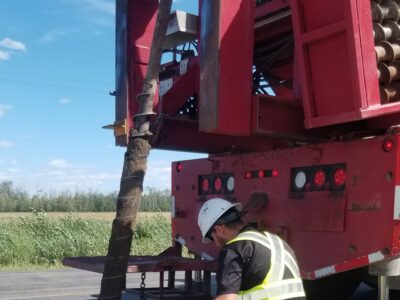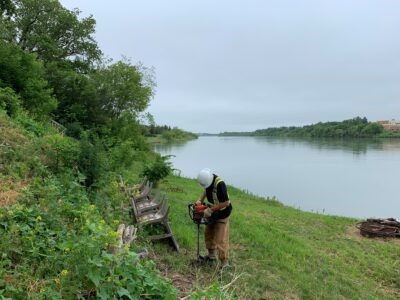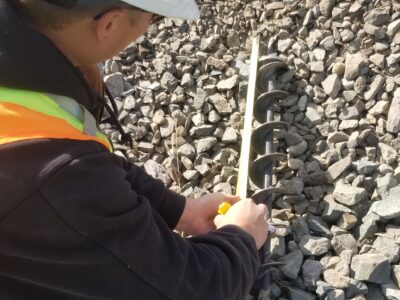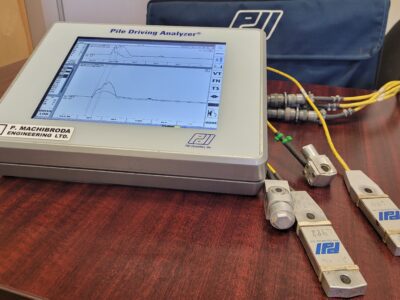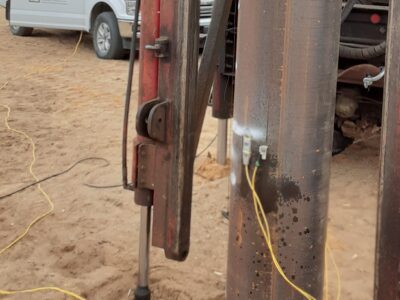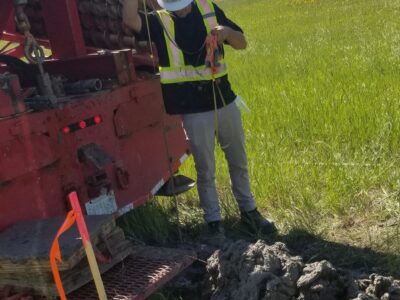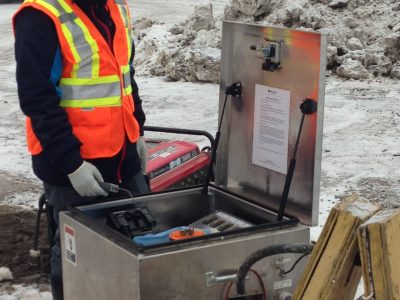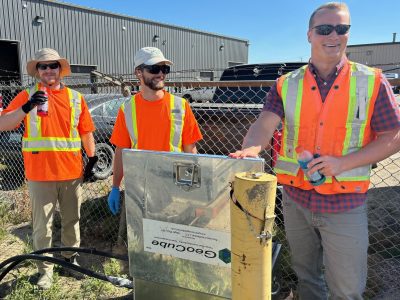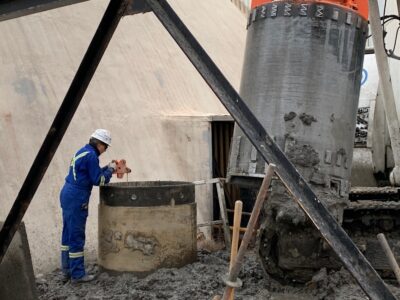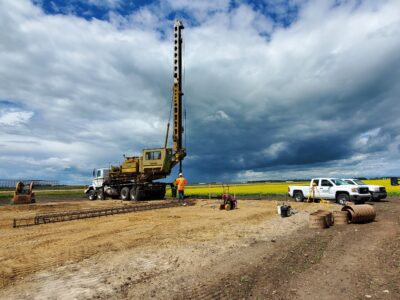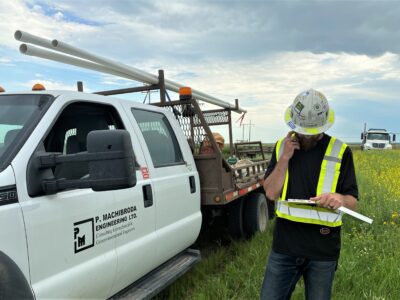Geotechnical Engineering
For anyone who wants to construct something on, in, or with the earth, we help them figure out how.
P. Machibroda Engineering Ltd. provides all facets of geotechnical engineering services to make your project a success. Whether your structure is a commercial/residential building, a grain elevator, a telecommunications tower, retaining wall, bridge, temporary crane support, etc., you need a solid foundation. From the preliminary design to final construction, we provide practical, cost effective solutions to help you complete your project. We have significant experience in the Saskatoon area and throughout the prairie provinces of Saskatchewan, Alberta and Manitoba. As a result of our in-house drill scheduling and lab capabilities, we can provide value added service to your projects. We like to think of ourselves as part of your design and construction team. We value our client relationships and can provide follow-up consulting services during the design, tendering and construction phases.
Our geotechnical services include:
Boring and sampling using our continuous flight auger drill rigs is the primary method used by P. Machibroda Engineering Ltd. on most projects to gather information on the subsurface soil and groundwater conditions. Our drill rigs have the ability to conduct both standard penetration (SPT) and cone penetration testing (CPTu) to evaluate the in-situ-strength of the ground. In situ testing is often more reliable than recovering undisturbed soil samples and evaluating strength in the lab. Having the ability to perform both SPT and CPTu on projects is a value-added service we provide our clients as it increases our confidence on the strength of the ground conditions which can assist with optimizing design parameters presented in our reports.
Slope stability analysis is implemented in numerous civil engineering projects to contribute to the safe and economic design of embankments, excavations, natural slopes, dams, landfills and spoil piles. In its simplest form, if the forces that resist the movement are greater than those driving the movement, the slope is considered stable. P. Machibroda Engineering Ltd. uses industry recognized software when undertaking slope stability assessments.
P. Machibroda Engineering Ltd. uses the Pile Driving Analyzer (PDA) system manufactured by Pile Dynamics Inc. to measure and evaluate pile capacity according to the high strain dynamic test method (ASTM D4945). During the test, sensors are attached to the pile to measure forces and motions of the pile after impact by a pile driving hammer. Software analysis is then undertaken on the recovered data using a data matching process (CAPWAP) to evaluate the mobilized pile capacity. Information on hammer performance and pile integrity can also be determined.
P. Machibroda Engineering Ltd. has extensive experience in providing subgrade reviews where confirmation is needed that the soil conditions encountered during construction are in conformance with the geotechnical report. Whether the review is to confirm the strength of the subgrade for support of a foundation element, floor slab, rail embankment or parking lot, between our site personnel and office staff, P. Machibroda Engineering Ltd. can provide guidance for a safe and economic design.
P. Machibroda Engineering Ltd. uses the Wave Equation Analysis of Pile Driving software (GRLWEAP) developed by Pile Dynamics Inc. to simulate pile response when driven with an impact or vibratory hammer. The GRLWEAP software allows one to estimate dynamic pile stresses and capacities using geotechnical information from the site for a given hammer/pile system. The analysis can be used to assess whether the pile will be overstressed at a certain penetration or if the pile will terminate prior to achieving the design embedment depth (i.e, driveability analysis). Prior to mobilizing the hammer to the site, GRLWEAP is an effective tool to estimate whether the chosen hammer can efficiently install the pile to the required depths. During pile installation, GRLWEAP can be used for estimating pile capacities when combined with PDA testing and field observed blow counts.
Upon completion of site characterization and exploration, a geotechnical report is prepared providing foundation design recommendations tailored towards what is being built. Our geotechnical reports typically include recommendations for site preparation, excavations and dewatering, deep and shallow foundations, foundation settlement, floor slabs, foundation walls, foundation concrete and roadway/parking lot surfacing structures.
Whether it is a permitting requirement or the owners desire to have an independent third-party document the as-built pile dimensions, P. Machibroda Engineering Ltd. has well-trained staff capable of providing this service for all pile types. Our personnel can be on-site from the start to end of the piling, compiling records for each pile installed. After pile installation is completed, a summary report is prepared that includes the pile number, the pile type, the date of installation, the design and installed pile dimensions, information pertinent to the pile type (i.e., reinforcing steel, installation torque, driving energy, grout factor, etc.) and any construction difficulties encountered during installation.
P. Machibroda Engineering Ltd. uses a Pile Integrity Testing (PIT) system to estimate pile depth and evaluate whether the pile had any major defects. The equipment and procedures for conducting the low strain integrity testing are undertaken in accordance with ASTM D-5882, “Standard Test Method for Low Strain Impact Integrity Testing of Deep Foundations”. A sensor (accelerometer) is attached to the pile top to measure acceleration after impact by a small hand-held hammer. The acceleration signal is converted to a velocity record by the PIT system and software analysis is undertaken on the recovered data using the PIT-W program to evaluate the pile shaft.
Earth retaining structures are systems used to hold back soil and accommodate changes in ground surface elevation. These structures are designed to withstand the forces exerted by the retained ground or “backfill” and other externally applied loads, and to safely maintain the desired ground elevation differences. Examples of retaining structures include segmental block, cantilever cast-in-place concrete, sheet piling, mechanically stabilized earth (MSE), geosynthetic reinforced soil (GRS) and slopes. P. Machibroda Engineering Ltd. uses industry recognized software when undertaking earth retaining structure analysis.
Traffic structure design is completed for asphalt concrete, concrete (reinforced and unreinforced), and gravelled structures. The design of traffic structures require a thorough understanding of soil strength, characteristics, and behavior. Design methods typically utilized by P. Machibroda Engineering Ltd. include AASHTO 1993, Sask Highways Shell Curve, Pavement ME, and Giroud Han. The above-mentioned design methods analyze the performance of the subgrade soils and granular fill under imposed traffic wheel loads and environmental conditions.

